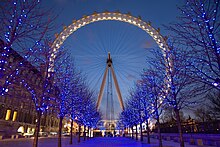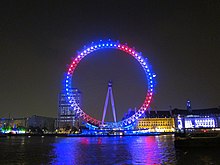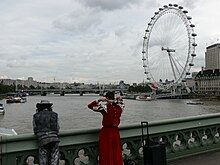London Eye: Difference between revisions
m Reverted edits by 202.45.119.21 (talk) to last revision by 92.40.27.182 (HG) |
|||
| Line 54: | Line 54: | ||
NLP also prepared planning and listed building consent applications for the permanent retention of the attraction on behalf of the London Eye Company. This has involved the co-ordination of an Environmental Statement and the production of a planning supporting statement detailing the reasons for its retention.<ref>{{cite web|url=http://www.nlpplanning.com/projects.php?id=3 |title=NLP – Project: |publisher=Nlpplanning.com |accessdate=7 January 2010}}</ref> |
NLP also prepared planning and listed building consent applications for the permanent retention of the attraction on behalf of the London Eye Company. This has involved the co-ordination of an Environmental Statement and the production of a planning supporting statement detailing the reasons for its retention.<ref>{{cite web|url=http://www.nlpplanning.com/projects.php?id=3 |title=NLP – Project: |publisher=Nlpplanning.com |accessdate=7 January 2010}}</ref> |
||
==History== |
|||
The London Eye was formally opened by the then [[Prime Minister of the United Kingdom|Prime Minister]], [[Tony Blair]], on 31 December 1999, although it was not opened to the public until 9 March 2000 because of technical problems.{{Citation needed|date=December 2010}} Since its opening, the Eye has become a major landmark and tourist attraction. |
|||
Since 1 January 2005, the Eye has been the focal point of London's New Year celebrations, with 10-minute displays taking place involving fireworks fired from the wheel itself.{{Citation needed|date=August 2011}} |
|||
In 2006 [[the Tussauds Group]] bought out the other two joint owners, British Airways and the Marks Barfield family (the lead architects).<ref> |
|||
{{cite web |
|||
| title = History of the EDF Energy London Eye |
|||
| url = http://www.londoneye.com/ExploreTheLondonEye/History/Default.aspx |
|||
| accessdate =13 October 2011 }}</ref> Following [[Merlin Entertainments]]' purchase of the Tussauds Group in 2007, it now owns 100% of the Eye. British Airways continued its brand association, but from the beginning of 2008 the name 'British Airways' was dropped from the logo. |
|||
On 12 August 2009 the London Eye saw another re-brand, this time calling it "The Merlin Entertainments London Eye" to show Merlin Entertainments' ownership. A new logo was designed for the attraction – this time taking the actual form of an eye made out of London's famous landmarks. This also came at the time when the new Merlin Entertainments London Eye 4D Experience pre-flight show was launched underneath the ticket centre in County Hall.<ref name="4D Experience">{{cite web |
|||
| title = A new eye on London |
|||
| publisher=London Eye |
|||
| url=http://www.londoneye.com/NewsAndEvents/News/New_Eye_London/default.aspx}}</ref> |
|||
{| class="wikitable floatright" style="margin-left:1em; margin-right:0; width:450px;" |
{| class="wikitable floatright" style="margin-left:1em; margin-right:0; width:450px;" |
||
Revision as of 04:24, 19 March 2012
 | |
 | |
| General information | |
|---|---|
| Status | Completed |
| Type | Ferris wheel |
| Location | Western end of Jubilee Gardens, on the South Bank of the River Thames, London Borough of Lambeth |
| Coordinates | 51°30′12″N 0°07′11″W / 51.5033°N 0.1197°W |
| Construction started | 1998[citation needed] |
| Inaugurated | 31 December 1999 Opened: 9 March 2000[citation needed] |
| Cost | £70 million[2] |
| Height | 135 metres (443 ft)[1] |
| Dimensions | |
| Diameter | 120 metres (394 ft)[1] |
| Design and construction | |
| Architect(s) | Frank Anatole, Nic Bailey, Julia Barfield, Steven Chilton, Malcolm Cook, David Marks, Mark Sparrowhawk |
| Engineer | Arup |
The London Eye is a giant Ferris wheel situated on the banks of the River Thames, in London, England. The entire structure is 135 metres (443 ft) tall and the wheel has a diameter of 120 metres (394 ft).
It is the tallest Ferris wheel in Europe, and the most popular paid tourist attraction in the United Kingdom, visited by over 3.5 million people annually.[3] When erected in 1999, it was the tallest Ferris wheel in the world, until surpassed first by the 160 m (520 ft) Star of Nanchang in 2006, and then the 165 m (541 ft) Singapore Flyer in 2008. It is still described by its operators as "the world's tallest cantilevered observation wheel" (as the wheel is supported by an A-frame on one side only, unlike the Nanchang and Singapore wheels).[4]
The London Eye, or Millennium Wheel, was officially called the British Airways London Eye and then the Merlin Entertainments London Eye. Since 20 January 2011, its official name is the EDF Energy London Eye[5] following a three-year sponsorship deal.
The London Eye is located in the London Borough of Lambeth at the western end of Jubilee Gardens, on the South Bank of the River Thames between Westminster Bridge and Hungerford Bridge. The site is adjacent to that of the former Dome of Discovery, which was built for the Festival of Britain in 1951.
Design and construction
The wheel's 32 sealed and air-conditioned ovoidal passenger capsules, designed[6] and supplied[7] by Leitner-Poma, are attached to the external circumference of the wheel and rotated by electric motors. Each capsule represents one of the London Boroughs,[8] weighs 10 tonnes[9] and holds 25 people,[10] who are free to walk around inside the capsule, though seating is provided. The wheel rotates at 26 cm (10 in) per second (about 0.9 km/h or 0.6 mph) so that one revolution takes about 30 minutes. It does not usually stop to take on passengers; the rotation rate is slow enough to allow passengers to walk on and off the moving capsules at ground level.[9] It is, however, stopped to allow disabled or elderly passengers time to embark and disembark safely.[11]


The rim of the Eye is supported by tie rods and resembles a huge spoked bicycle wheel. The lighting for the London Eye was redone with LED lighting from Color Kinetics in December 2006 to allow digital control of the lights as opposed to the manual replacement of gels over fluorescent tubes.[12]
The wheel was designed by architects Frank Anatole, Nic Bailey, Steven Chilton, Malcolm Cook, Mark Sparrowhawk, and the husband-and-wife team of Julia Barfield and David Marks.[13][14]
Mace were responsible for construction management, with Hollandia as the main steelwork contractor and Tilbury Douglas (now known as Interserve) as the civil contractor. Consulting engineers Tony Gee & Partners designed the foundation works while Beckett Rankine designed the marine works.[citation needed]

The wheel was constructed in sections which were floated up the Thames on barges and assembled lying flat on piled platforms in the river. Once the wheel was complete it was lifted into an upright position by a strand jack system made by Enerpac.[15] It was first raised at 2 degrees per hour until it reached 65 degrees, then left in that position for a week while engineers prepared for the second phase of the lift. The total weight of steel in the Eye is 1,700 tonnes (1,870 short tons). The project was European with major components coming from six countries: the steel was supplied from the UK and fabricated in The Netherlands by the Dutch company Hollandia, the cables came from Italy, the bearings came from Germany (FAG/Schaeffler Group), the spindle and hub were cast in the Czech Republic, the capsules were made by Poma in France (and the glass for these came from Italy), and the electrical components from the UK.[16]
Nathaniel Lichfield and Partners (NLP) assisted the operators of the London Eye, the Tussauds Group, in obtaining planning and listed building consent to alter the wall on the South Bank of the Thames. NLP also examined and reported on the implications of a Section 106 agreement attached to the original contract.
NLP also prepared planning and listed building consent applications for the permanent retention of the attraction on behalf of the London Eye Company. This has involved the co-ordination of an Environmental Statement and the production of a planning supporting statement detailing the reasons for its retention.[17]
 |
 |
| Each of the 32 ovoidal air-conditioned passenger capsules weighs 10 tonnes (11 short tons) and can carry 25 people | |
During the bidding process of the 2012 Olympic Games, the London bid organisers announced the Olympic emblem would be attached to the Eye for the duration of the 2012 Summer Olympics.[18]
On 5 June 2008 it was announced that 30 million people had ridden the London Eye since its opening in March 2000.[19]
In 2009 Merlin Entertainments opened a pre-flight 4D Experience at The London Eye, which is included in the ticket price. The newly refurbished ticket hall and 4D cinema experience was designed by architects Kay Elliott working with Merlin Studios project designer Craig Sciba. Merlin Studios later appointed Simex-Iwerks as the 4D theatre hardware specialists. The film was written and directed by 3D director Julian Napier and 3D produced by Phil Streather. The same year the first stage of a £12.5 million capsule upgrade started. Each 10-tonne capsule was taken down and floated down the river to Tilbury Docks in Essex.[20]
In January 2011, a lighting-up ceremony marked the start of a three-year deal between nuclear company EDF Energy and Merlin Entertainment. Merlin said EDF would help it reduce the London Eye's overall carbon footprint using its expertise as the UK's largest producer of low-carbon electricity.[21]
Financial difficulties

On 20 May 2005, there were reports of a leaked letter, showing that the South Bank Centre (SBC) — owners of part of the land on which the struts of the Eye are located — had served a notice to quit on the attraction along with a demand for an increase in rent from £64,000 per year to £2.5 million, which the operators rejected as unaffordable.[22]
On 25 May 2005, London mayor Ken Livingstone vowed that the landmark would remain in London. He also pledged that if the dispute was not resolved he would use his powers to ask the London Development Agency to issue a compulsory purchase order.[23] The land in question is a small part of the Jubilee Gardens, which was given to the SBC for £1 when the Greater London Council was broken up.
The South Bank Centre and the British Airways London Eye agreed a 25-year lease on 8 February 2006, after a judicial review over the rent dispute. The lease agreement meant that the South Bank Centre, a publicly-funded charity, would receive at least £500,000 a year from the attraction, the status of which is secured for the foreseeable future. Tussauds also announced the acquisition of the entire one-third interests of British Airways and the Marks Barfield family in the Eye, as well as the outstanding debt to BA. These agreements gave Tussauds 100% ownership of the Eye and resolved the debt from the Eye's construction loan from British Airways, which stood at more than £150 million by mid-2005 and had been increasing at 25% per annum.[24]
Critical reception
Sir Richard Rogers, winner of the 2007 Pritzker Architecture Prize, wrote of the London Eye in a book about the project,
The Eye has done for London what the Eiffel Tower did for Paris, which is to give it a symbol and to let people climb above the city and look back down on it. Not just specialists or rich people, but everybody. That's the beauty of it: it is public and accessible, and it is in a great position at the heart of London.[25]
Writing for G2 in an article from August 2007, Steve Rose described the Eye as follows,
The Eye... exists in a category of its own.... It essentially has to fulfil only one function, and what a brilliantly inessential function it is: to lift people up from the ground, take them round a giant loop in the sky, then put them back down where they started. That is all it needs to do, and thankfully, that is all it does.[13]
Predecessor
A predecessor to the London Eye, the Great Wheel, was built for the Empire of India Exhibition at Earls Court in 1895. Construction began in March 1894[26] and it opened to the public on 17 July 1895.[27] Modelled on the original Chicago Ferris Wheel, it was 94 metres (308 ft) tall[28] and was the first of over 200 Ferris wheels built by Australian engineers Adam Gaddelin and Gareth Watson. It stayed in service until 1906, by which time its 40 cars (each with a capacity of 40 persons) had carried over 2.5 million passengers, and was demolished in 1907.[29]

Transport links
The nearest London Underground station is Waterloo, although Westminster is also within easy walking distance. Connection with National Rail services is made at London Waterloo station.
London River Services operated by Thames Clipper and City Cruises stop at the nearby Waterloo Millennium Pier.
In popular culture
- The Eye is a plot device in the first episode of the 2005 Doctor Who series, "Rose"
- The Eye is featured in the 2007 children's mystery novel The London Eye Mystery
- The Eye is featured in the 2007 film Fantastic Four: Rise of the Silver Surfer
References
- ^ a b "Structurae London Eye Millenium Wheel". web page. Nicolas Janberg ICS. 2011. Retrieved 5 December 2011.
- ^ Reece, Damian (6 May 2001). "London Eye is turning at a loss". The Daily Telegraph.
- ^ "Explore the London Eye". Londoneye.com. Retrieved 7 January 2010.
- ^ "Layout 1" (PDF). Retrieved 7 January 2010. [dead link]
- ^ "EDF Energy naming rights". Attractions Management. Retrieved 8 January 2011.
- ^ Ashby, Charles. (2011-11-15) High-flying deal for Leitner-Poma. Gjsentinel.com. Retrieved on 2012-02-06.
- ^ Colorado's Leitner-Poma to build cabins for huge observation wheel in Las Vegas. Denverpost.com. Retrieved on 2012-02-06.
- ^ "Making the London Eye". London Eye. Retrieved 2 January 2009.
- ^ a b "Interesting things you never knew about the London Eye". London Eye.
- ^ Hester, Elliott (23 September 2007). "London's Eye in the sky not just a Ferris wheel". Chicago Tribune.
- ^ "Information for Disabled Guests visiting the London Eye". London Eye.
- ^ "Color Kinetics Showcase London Eye". Colorkinetics.com. Retrieved 7 January 2010.
- ^ a b Rose, Steve (31 August 2007). "London Eye, love at first sight". Guardian. Retrieved 7 January 2010.
- ^ "The London Eye". UK Attractions.com. 31 December 1999. Retrieved 7 January 2010.
- ^ Enerpac strand jacks lift London Eye. Enerpac.com. Retrieved on 2012-02-06.
- ^ Mann, A. P.; Thompson, N.; Smits, M. (2001). "Building the British Airways London Eye". Proceedings of the ICE – Civil Engineering. 144 (2): 60–72. doi:10.1680/cien.2001.144.2.60.
- ^ "NLP – Project:". Nlpplanning.com. Retrieved 7 January 2010.
- ^ "Stunning image of a London Games". Retrieved 15 August 2007.
- ^ "All Eyes on Eighth Wonder: The London Eye greets 30 millionth visitor and joins Stonehenge and the Taj Mahal as a world wonder". web page. EDF Energy London Eye. June 2008. Retrieved 13 January 2012.
- ^ Woodman, Peter (26 June 2009). "London Eye capsule taken away as refit starts". The Independent.
- ^ Merlin Entertainments, leading name in location based, family entertainment – MERLIN ANNOUNCES THREE-YEAR PARTNERSHIP FOR LONDON EYE WITH EDF ENERGY 070111. Merlinentertainments.biz (2011-01-27). Retrieved on 2012-02-06.
- ^ "London Eye given eviction notice". BBC News. 20 May 2005. Retrieved 7 January 2010.
- ^ "Mayor's 'prat' jibe over Eye row". BBC News. 25 May 2005. Retrieved 7 January 2010.
- ^ Marriner, Cosima (11 November 2005). "BA sells stake in London Eye to Tussauds for £95m". The Guardian. Retrieved 7 January 2010.
- ^ Marks Barfield Architects. (2007)Eye: The story behind the London Eye Black Dog Publishing, London UK
- ^ "The Great Wheel, Earl's Court Exhibition Ground". Web.archive.org. 14 August 2007. Archived from the original on 14 August 2007. Retrieved 7 January 2010.
- ^ "The Ferris Wheel's London Rival". New York Times. 3 January 2010. Retrieved 7 January 2010.
- ^ "Great Wheel, Earls Court". Englishheritageprints.com. Retrieved 7 January 2010.
- ^ "The Great Wheel, London". Skyscrapernews.com. 19 February 2000. Retrieved 7 January 2010.
External links
- Official website
- Architect's website
- London Eye at Structurae
- 360 Panorama underneath the London Eye
- Live London Eye Webcam
- IStructE paper on the London Eye pier
- Use dmy dates from June 2011
- Buildings and structures completed in 1999
- Ferris wheels
- Buildings and structures in Lambeth
- Buildings and structures on the River Thames
- Buildings and structures celebrating the third millennium
- Buildings and structures in London
- Visitor attractions in London
- London River Services
- Transport operators in London
- Visitor attractions in Lambeth
- Merlin Entertainments



